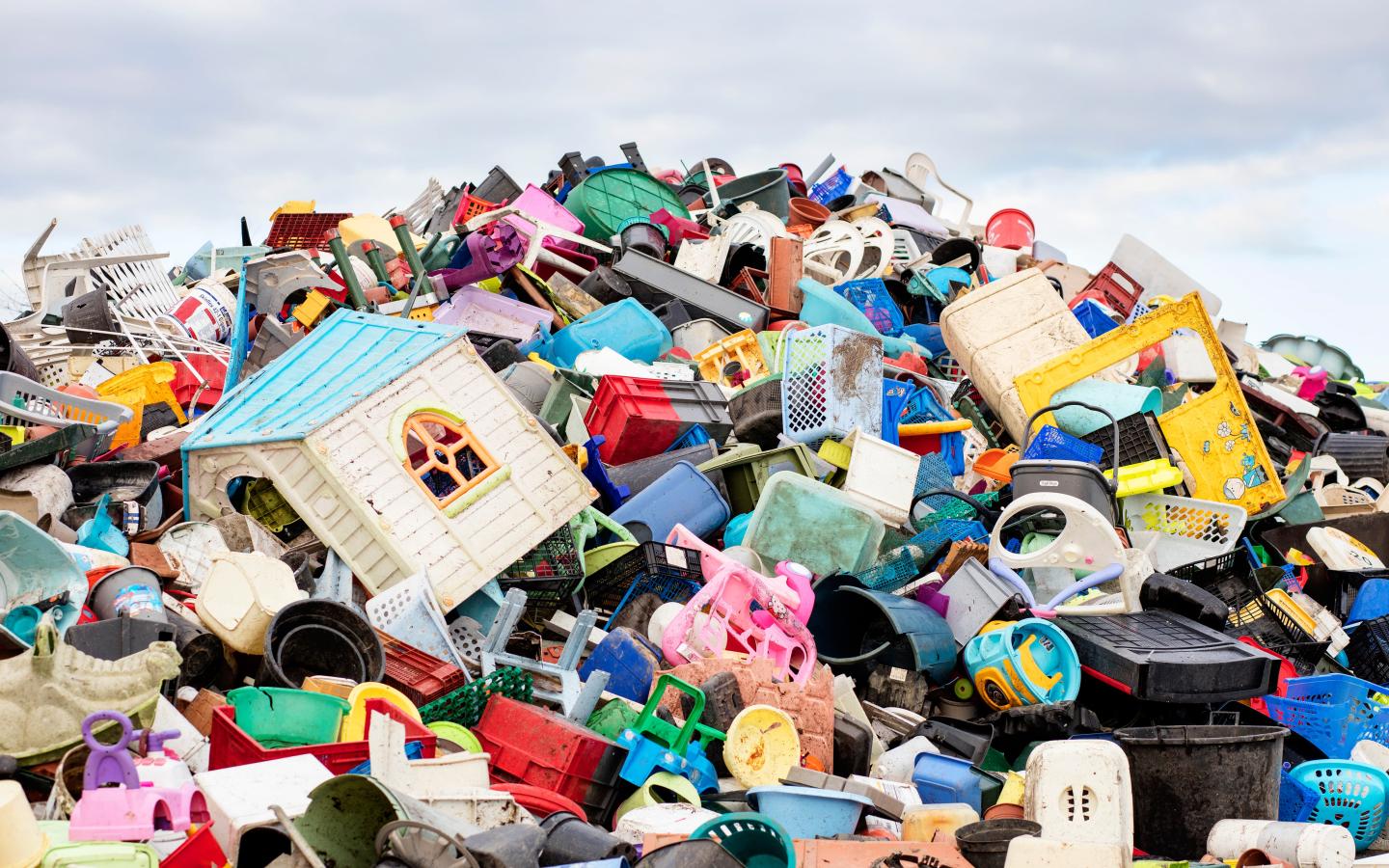
Plastic-burning plant pulls out of Pennsylvania community
The chemical industry, however, is still pushing this risky, polluting technology.
About two years ago, a chemical company proposed building a new plant to handle plastic waste in the tiny community of Point Township, Pennsylvania, where the west and north branches of the Susquehanna River meet.
Instead of traditional recycling — which involves mechanically grinding down and melting plastic waste, then combining it with virgin material to make recycled plastic products — the proposed plant would use an energy-intensive, polluting process to essentially burn plastic waste in incinerators and convert it into small amounts of liquid fuel.

On Friday, after a series of permitting setbacks, Encina, the company behind the proposal, announced it would no longer pursue a plant at that location.
“People in our area have made it clear that clean air, clean water, public health and recreation are community resources whose value cannot be overestimated,” said Sandy Field of Lewiston, Pennsylvania, in The Daily Item. Field co-founded a group of concerned residents, Save Our Susquehanna, to educate the community and elected officials about Encina’s plans.
The chemical industry calls the process used by plants like Encina’s “advanced recycling.” But Field and others call it greenwashing.
“The advertising suggests that it’s a healthy and climate-friendly process, something we would all want to get behind,” says Cynthia Palmer, a petrochemicals analyst for the advocacy group Moms Clean Air Force, which worked alongside SOS in Pennsylvania. “Unfortunately, when you study the details, you realize these are a particularly dangerous type of incinerator that burns plastic trash and turns it into hazardous air pollutants, chemical wastes, and heavily contaminated industrial fuels.”
The plastic problem
Plastics are made by combining chain-like chemicals derived from fossil fuels with chemical additives. These can include pervasive “forever chemicals” called PFAS, and heavy metals like cadmium and lead.
The facilities involved in plastics manufacturing collectively release millions of pounds of some of the most toxic chemicals into the air, land and water every year. An Environmental Defense Fund analysis of some 200 petrochemical facilities found that more than 80% have been out of compliance with environmental laws in the past three years.
- Is your neighborhood a toxic chemical hotspot?
- Harmful “forever” chemicals in drinking water: what you need to know
Once made, plastics don’t go away. In the U.S., the rate of plastic recycling is just 6%, with 27 million tons dumped into landfills in 2018.
Burning waste plastic will do little to address the crisis, says Maria Doa, a former head of EPA’s chemical risk management division who now leads chemical policy at EDF.

“A plastic waste stream can have up to 1,000 different chemicals in it,” says Doa. “When you heat plastic, you end up with this mishmash of chemicals, including hazardous waste and air pollutants. You get benzene, you get dioxins, you get phthalates. Companies say they’re going to make building blocks for new plastics, but from this mixture it's very difficult to directly create new products.”
The Encina plant would have retrieved just four chemicals for reuse — cancer-causing benzene, the nerve toxins toluene and xylene, and propylene. Long-lasting PFAS chemicals, which harm the immune system, reproductive system and increase the risk of certain cancers, could have contaminated the water the facility intended to draw from and return to the Susquehanna after treatment.
What’s more, Encina said its process would be self-powered — meaning that the facility could have run on a fuel made from pyrolysis oil, an end-product of burning plastic waste, which can have shockingly high cancer risks.
“Obscene” cancer risk
Recently, Chevron obtained EPA approval to make “sustainable fuels” from plastic-based pyrolysis oil by combining it with other petrochemicals. However, a 2023 ProPublica investigation of the approval revealed that air pollution from a proposed jet fuel made this way would carry a one in four cancer risk to people exposed across their lifetime. A proposed boat fuel was projected to cause cancer in every person exposed over their lifetime.
“I’ve never seen anything like this, and I used to run this program,” says Doa. “When the reporter shared it with me I was sure it was a mistake. A one in four cancer risk is horrendous. One in one? I can’t even imagine. I think someone called it obscene. And rightly so.”
The EPA has said that these risk estimates are conservative. So Doa and EDF went back to the agency for clarification. “We asked them, several times, if this is not representative, then what is a better estimate of risk for frontline communities? They never had an answer.”
Eventually, the agency released a different rule that technically hit pause on Chevron’s plans. But the approval is still on the books, and now other companies are trying to make similar fuels, says Doa, who is continuing to push the EPA to reconsider.
Skirting environmental laws
Encina says it is still considering other sites for similar facilities. And half the country appears ready to welcome them, thanks to lobbying by the American Chemistry Council. Twenty-five states have already passed laws that allow these types of plastic-burning facilities to skirt environmental regulations.
The Encina plant, for example, was classified as a manufacturing facility under Pennsylvania law, instead of a solid waste management facility. That classification means it will be exempt from important air pollution and monitoring and reporting regulations.
The ACC is lobbying Congress for the same changes to be made under federal law. And some major corporations, like L’Oreal and Procter & Gamble, having made pledges to reduce their plastic footprint, are backing these risky technologies. EDF, Moms Clean Air Force and others are working on Capitol Hill and with corporations to educate them on this issue.
“The industry is touting this as a solution to a problem, but it seems to be a case of greenwashing,” says Joanna Slaney, AVP of political affairs for EDF. “A business model that relies on removing Clean Air Act safeguards is a serious concern. When we talk to people on the Hill about what industry is asking for, about the harmful impacts on public health and the environment, they get it. NGOs are working together to ensure that this idea doesn’t gain traction with decision makers.”
Better ways to reduce plastic
Some recent advancements have made headway in reducing plastic use. Bag bans in U.S. states and cities have cut plastic bag consumption by 6 billion bags, according to Environment America. That’s enough to circle the earth 42 times. Consumers can buy plastic-free versions of products like envelopes, stir sticks, and toothbrushes, and refill reusable water bottles in airports and schools. And plant-based alternatives, such as bioplastics made from beets or mushrooms, are being developed (although composting can be tricky).
But with plastic production — and carbon emissions from it — expected to triple over the next 30 years, advocates say it’s not enough to reduce plastic use. And so-called “advanced recycling” is not the answer.


Consumer-based solutions can help, but won't be able to address massive increases in plastic production. (Getty)
“Plastics harm people along the entire supply chain, from fossil fuel extraction to transport, use, and disposal,” says Palmer of Moms Clean Air Force. “There’s no safe and effective way to manage plastic waste.”
Later this month, UN negotiators are gathering in Canada to discuss the world’s first global plastics treaty, which will be issued at the end of 2024. While the plastics industry is urging member nations to focus on so-called “advanced” or “chemical” recycling technologies, health and environmental advocates are seeking limits on plastic production, especially single-use plastics.
More than 150 groups have asked the Biden administration to negotiate a treaty that sets caps on plastic production and creates a shift to alternatives that will protect people and the environment.
“We try to put all the responsibility on ourselves, which is what the industry has been pushing for years — personal responsibility,” says Palmer. “But it’s a systemwide problem that needs a systemwide solution.”
This article is based on a 3-part series about the failures of plastic recycling, written by Austyn Gaffney for Moms Clean Air Force.


